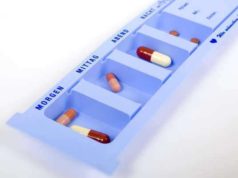
The controlled substances found in Schedule III of the Controlled Substances Act are considered to be less dangerous than those in Schedule II of the drug laws according to their classification. Drug laws provide that Schedule III controlled substances must meet the following criteria:
The drug or substance has a potential for abuse and/or addiction less than those found in Schedule II;
The drug or substance has proven to have applications for medical treatments or applications;
Abuse of the drug or substance may lead to moderate to low physical dependence or moderate to high psychological dependence.
Drug laws state that Schedule III controlled substances are strictly regulated under drug laws and are only legally available by prescription. All controlled substances in Schedule III are considered to be prescription drugs as stated by drug laws such as the Federal Food, Drug, and Cosmetic Act.
Schedule III controlled substances may be dispensed only by written prescription as given by a medical practitioner. Oral prescriptions are also allowed, as long as they abide by the drug laws provided by the Controlled Substances Act.
Schedule III prescriptions have a lifetime of six months after the original date of dispensation. It may not be refilled after that time span unless a new prescription is given. Also, the prescription may not be filled more than five times after the original date of dispensation. The prescription must be renewed in order to refill more than the allowed five times.
Some of the drug law-based Schedule III controlled substances are:
Anabolic steroids, including prohormones
Bartbiturates that have immediate-acting qualities
Ketamine
Xyrem
Vicodin
Marinol
Most of these drugs are used in the medical field, but have also been abused and used on the recreational level. Ketamine is often used as a veterinary and pediatric anesthetic and was created as a mild substitute for PCP. Xyrem is often prescribed to treat narcolepsy and is a type of preparation of GHB, which is found in Schedule I. Marinol is a synthetically derived version of Tetrahydrocannabinol, or THC, commonly prescribed for nausea and vomiting as a result of chemotherapy. AIDS patients may also be prescribed Marinol in order to treat appetite loss. THC is a main component of marijuana or cannabis, which is found in Schedule I.
Anabolic steroids and prohormones are also in Schedule III, and have been the recent topic of debate in the sports world, particularly baseball. Many athletes were brought to trial to testify about their alleged use of anabolic steroids and other compounds such as prohormones while active members of the MLB. Steroids have become a problem in terms of their ability to enhance performance in athletic events or sports and have been under scrutiny regarding their illegal use in certain sports.
Anabolic steroids have been used in the medical field to aid in certain treatments, but their abuse and/or illegal use is most notorious and known. Even though they have legitimate medical use, anabolic steroids and prohormones are still considered controlled substances and are placed in Schedule III of the Controlled Substances Act.

























